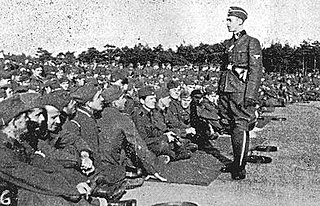 W
WThe Army of the Federation of Bosnia and Herzegovina was the military of the Federation of Bosnia and Herzegovina created after the 1995 Dayton Agreement. It consisted of two merging units which had been in conflict with each other during the Croat-Bosniak War: the Bosniak Army of the Republic of Bosnia and Herzegovina (ARBiH) and the Croat Croatian Defence Council (HVO). In 2005 it was integrated into Armed Forces of Bosnia and Herzegovina controlled by the Ministry of Defense of Bosnia and Herzegovina.
 W
WThe Army of the Republic of Bosnia and Herzegovina, often referred to as Bosnian Army, was the military force of the Republic of Bosnia and Herzegovina. It was established by the government of Bosnia and Herzegovina in 1992 following the outbreak of the Bosnian War. Following the end of the war, and the signing of the Dayton Peace Agreement in 1995, it was transformed into the Army of the Federation of Bosnia and Herzegovina. The ARBiH was the only military force on the territory of Bosnia and Herzegovina recognised as legal by other governments. Under the State Defense Reform Law the Armed Forces of Bosnia and Herzegovina were unified into a single structure, the Armed Forces of Bosnia and Herzegovina (OSBiH), making entity armies defunct.
 W
WThe Bosnian-Herzegovinian Infantry, commonly called the Bosniaken, were a branch of the Austro-Hungarian Army. Recruited from outside the Austrian and Hungarian regions of the Dual-Monarchy, with a significant proportion of Muslim personnel (31.04%), these regiments enjoyed a special status. They had their own distinctive uniforms and were given their own numbering sequence within the Common Army (KuK).
 W
WIn 926 a battle was fought in the Bosnian highlands between the armies of the Bulgarian Empire, under the rule of Bulgarian Tsar Simeon I, who at the time also fought a war with the Byzantine Empire, and the Kingdom of Croatia under Tomislav, the first king of the Croatian state. The battle is also known as the Battle of the Bosnian Highlands. It was fought in the mountainous area of Eastern Bosnia near the rivers Bosna and Drina, the border area between the Kingdom of Croatia and the Bulgarian Empire.
 W
WGreen cadres (paramilitary) was a Bosniak nationalist paramilitary force during World War II. They were founded in early December 1941 as a reaction to a massacre on Bosniak men and women carried out in Foča by the Serb Chetniks. The organisation was formed in poor conditions and was not so supported at first by the Croatian puppet government. They rose to power after the Partisans started to burst deeper into Bosnia. Their leader was Nešad Topčić.
 W
WThe Implementation Force (IFOR) was a NATO-led multinational peace enforcement force in Bosnia and Herzegovina under a one-year mandate from 20 December 1995 to 20 December 1996 under the codename Operation Joint Endeavour.
 W
WHalim Malkoč was a Bosniak Imam and SS Obersturmführer in the Waffen-SS division Handschar, and the first Muslim awarded the German Iron Cross during World War II. He received the medal for his involvement in the suppression of the Villefranche-de-Rouergue mutiny of 1943.